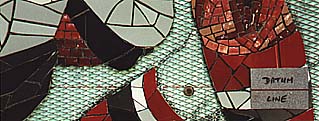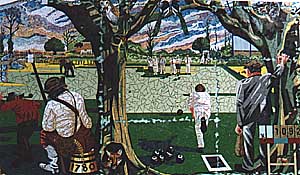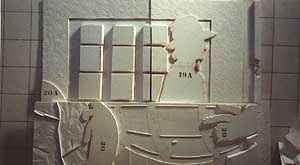
 |

BUDD MOSAICSIn 1992 Paul Bentley visited father and son mosaic artists Kenneth and Oliver Budd at their studio, the Old Barn, and wrote a feature article about them for the Winter 1992 issue of Mosaic Matters, which we are reproducing here because of its great interest for all mosaicists.
MOSAIC AT THE OLD RED BARNKenneth and Oliver Budd are a father and son team of mosaic artists, whose delightful studio is the Old Barn at Betsoms Farm, just outside Westerham in Kent. Kenneth Budd started making mosaics in the early sixties, and his first commission was for Kettering Grammar School, using the direct method on an outside wall. That wet and windy experience led him to devise a method which kept one of the principal advantages of working direct (you can see precisely what the final effect will be) but meant that you could do the bulk of the work in a comfortable studio. His solution was to work direct onto sheets of aluminium mesh, which could then be taken to the site, fixed, finished off and grouted relatively swiftly. The initial design is prepared at 1/2" to the foot, and the full-size cartoon is fixed to the walls, in sections if the mosaic is larger than the barn, of course, as it often is. The cartoon is covered with polythene sheet and then the four-foot squares of aluminium mesh are screwed on, which stops the cartoon stretching and allows the design to be seen.
The Budds normally use a mixture of smalti and cut tile. When I visited them in August, Oliver was working on a Pontypool Rugby Club mosaic using smalti by Orsoni, but Kenneth had vivid memories of other makes, especially Mellini of Florence, now alas defunct. He also showed me some old filarti, thin rods of coloured glass - he would love to get his hands on more. The tiles, matt and gloss, are imported from Germany and come in a good range of colours. Smalti and tile are bedded into Bal-flex, which they have used successfully for many years, and which has a rubbery texture when set. The completed squares can be easily handled by two people. They also use pebble aggregate, but that is applied direct into mortar on site. A coat-of-arms floor mosaic in marble for the Civic Centre in Newport prompted Kenneth to invent a nipping device for cutting strips of 10 and 12 mm marble tile into tesserae. The Budds have been making mosaics for 30 years, and the sheer scale of their work is impressive, ranging from small smalti panels up to a 370 by 10 metre whole-tile wall on the A442/M54 link road, at Sned's Hill.
During my visit I went to the White Oak Bowls Centre at Swanley, Kent, to watch Oliver installing a 12 square metre smalti-and-cut-tile wall mosaic. It is a triptych depicting three bowling scenes (dated 1630, 1780 and 1992) framed by trees peopled (animaled?) by a fox, a woodpecker, a butterfly and other creatures. He was at the stage of filling in the joins between the sheets, to be followed by grouting with Bal-grout. Being an indoor mosaic there was no difficulty about the wall, but outdoor sites can be a problem. Before installation, a position below a road (an underpass for example) has to be carefully sealed to keep out the salt water that will inevitably seep through to the back of the mosaic in the course of time. Mosaic may be "painting for eternity", but the combination of weather, the public and time means that you need to keep an eye on it. (The plaster of some Byzantine dome mosaics is literally hanging off the brickwork, supported only by its own curvature.) So the Budds offer a twice-yearly aftercare service for all their work. (The Byzantines withdrew theirs after 1453.) I was interested in the time scale for the bowls mosaic. The Sevenoaks Council first enquired in January; the design (40% smalti, 60% tile) was ready within a month and was approved in a few days. Oliver began work in late February. They can make 2 to 3 square feet a day, depending on the complexity of the design, and assuming that there is more tile than smalti. If it is just tile, 16 square feet a day is possible; on the other hand a smalti face might take a day. The studio work was completed by the end of July, and the mosaic was installed in August in under a week.
Back at the barn Kenneth was working at his current project, preparing polystyrene moulds for bas-relief concrete murals on the Pontypool by-pass. It seems astonishing that polystyrene is strong enough to act as a mould for concrete, but it is, and has the great merit of being easy to carve and light to carry. A concrete mural can of course incorporate pebble aggregate and mosaic insets by way of adding colour and variety of texture. The Budds are members of the distinguished Art Workers Guild, and it is entirely appropriate that Kenneth is the current Master of the Guild.
Sadly, Kenneth Budd died in 1995, but Oliver has carried on the proud traditions of the firm, and now trades as Oliver Budd's Mosaic Studio, Unit 5A, Crown Yard, Bedgebury Estate, Goudhurst, Kent TN17 2QZ phone (01580) 212 643 fax (01580) 754 971. If you would like to know more about Budd Mosaics you can do no better than paying a visit to his website www.buddmosaics.co.uk
|
All
content is copyright of © Mosaic Matters and its contributors.
All rights reserved
Mosaic
Matters is:
Editor: Paul Bentley
Web Manager/Designer: Andy Mitchell



